As far as SpaceX hit the launch prices
Recently, Ilon Musk tweeted on Twitter that SpaceX launches are so much cheaper than Boeing / Lockheed services that a satellite can be built for difference.
In 2014, the Court of Auditors issued a report on the evaluation of the cost of the US Air Force program to launch secret satellites, which were launched exclusively by ULA. Due to lack of transparency in pricing, it was difficult to compare price tags with the offer from SpaceX.
The government pays ULA a fixed amount, regardless of whether the rocket was used during the launch, be it Atlas V, Delta IV, or Delta IV Heavy. In addition, there is an EELV Launch Capability (ELC) contract, under which ULA receives $ 860 million dollars annually to provide access to space, even if there were no launches. Also, in total, ULA received $ 5 billion in other expenses related to missile production equipment.
The ULA monopoly ended when SpaceX began to struggle for payload launches for national security. The first launch was carried out in May of this year, by order of the National Intelligence Agency, in the form of a secret satellite NROL-76. According to the government, when compared directly with ULA, the cost of SpaceX launches is much lower.
For example, 14 months ago, the US Air Force signed a contract with SpaceX for $ 83 million to launch a GPS 3 satellite, and in March 2017 another contract was launched to launch another GPS 3 satellite worth $ 96.5 million. This is the total cost of the launch, which the government will pay, and this cannot be compared with the $ 422 million for a single launch, which is included in the Air Force budget for 2020.
How will competitors respond?
Next, we will look at how the cost of launches from Falcon 9 competitors has changed and will change, what steps the launch services market participants are going to take so as not to lose their place in the sun.
Blue origin
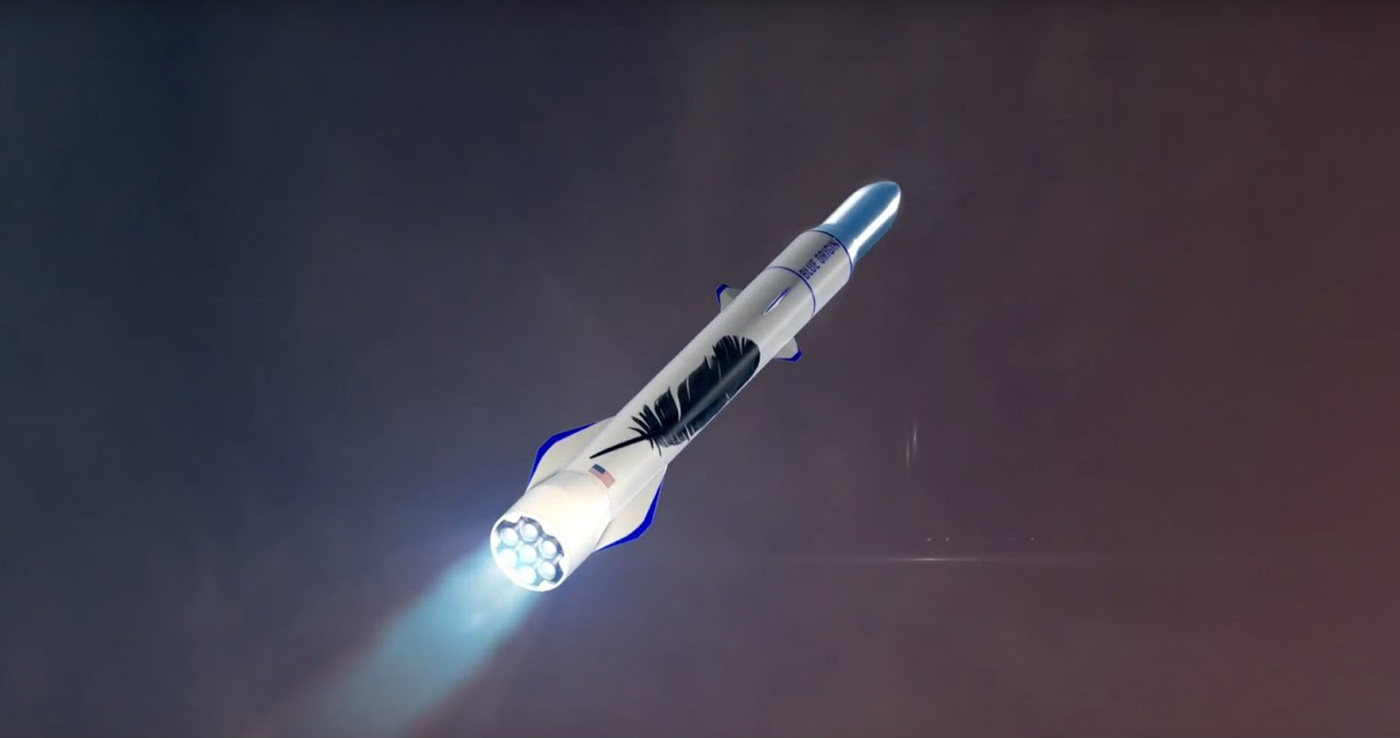
PH New Glenn. Source: Blue Origin
The goal of the company's founder, Jeff Bezos, is not at all profit from commercial satellite launches, but providing millions of people with the opportunity to live and work in space. He also has no ambitions to launch government and military satellites and plans only to supply his BE-4 engines to the new launch vehicle ( PH) ULA Vulcan. The BE-4 rocket engine, running on a mixture of liquid oxygen and liquefied natural gas, began to be developed in 2011 and more than $ 1 billion was spent on development. The BE-4 thrust was raised to 550 ts at the request of ULA.
The same engine is planned to be used at the first stage of the Blue Origin New Glenn rocket and the first launch will be carried out not earlier than 2020. The launch price of the New Glenn (NG) is not yet known, but it can be expected that the cost will be comparable to the Falcon 9, and its carrying capacity will be 13 tons per geo-transitional orbit (GPO).
Considering the experience of the suborbital launches of the New Shepard's vertical take-off and landing system, when the same stage was launched 5 times without significant modifications, this experience will make it possible to work out the first steps landing for several years after the first launch of NG.
ULA
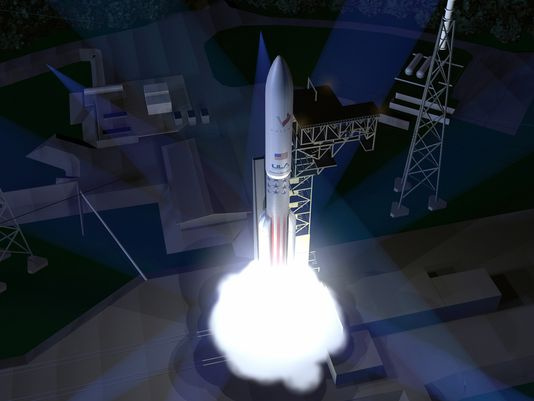
Vulcan booster. Source: ULA
The launch price for government and commercial loads is very different. The pressure of Mask at the hearings, with the proposal to ban fly on the Russian RD-180 for the Atlas 5 PH and leave the completely unfavorable Delta IV, gave their results. They decided to abandon the engine and allocated significant funds to create a replacement. ULA, when choosing an engine for its new PH Vulcan, between AR1 and BE-4, was inclined in favor of the second. AR1 is lagging behind in development for several years, does not imply reusable use, and also the development company relies mainly on public funds, in contrast to the private BE-4.
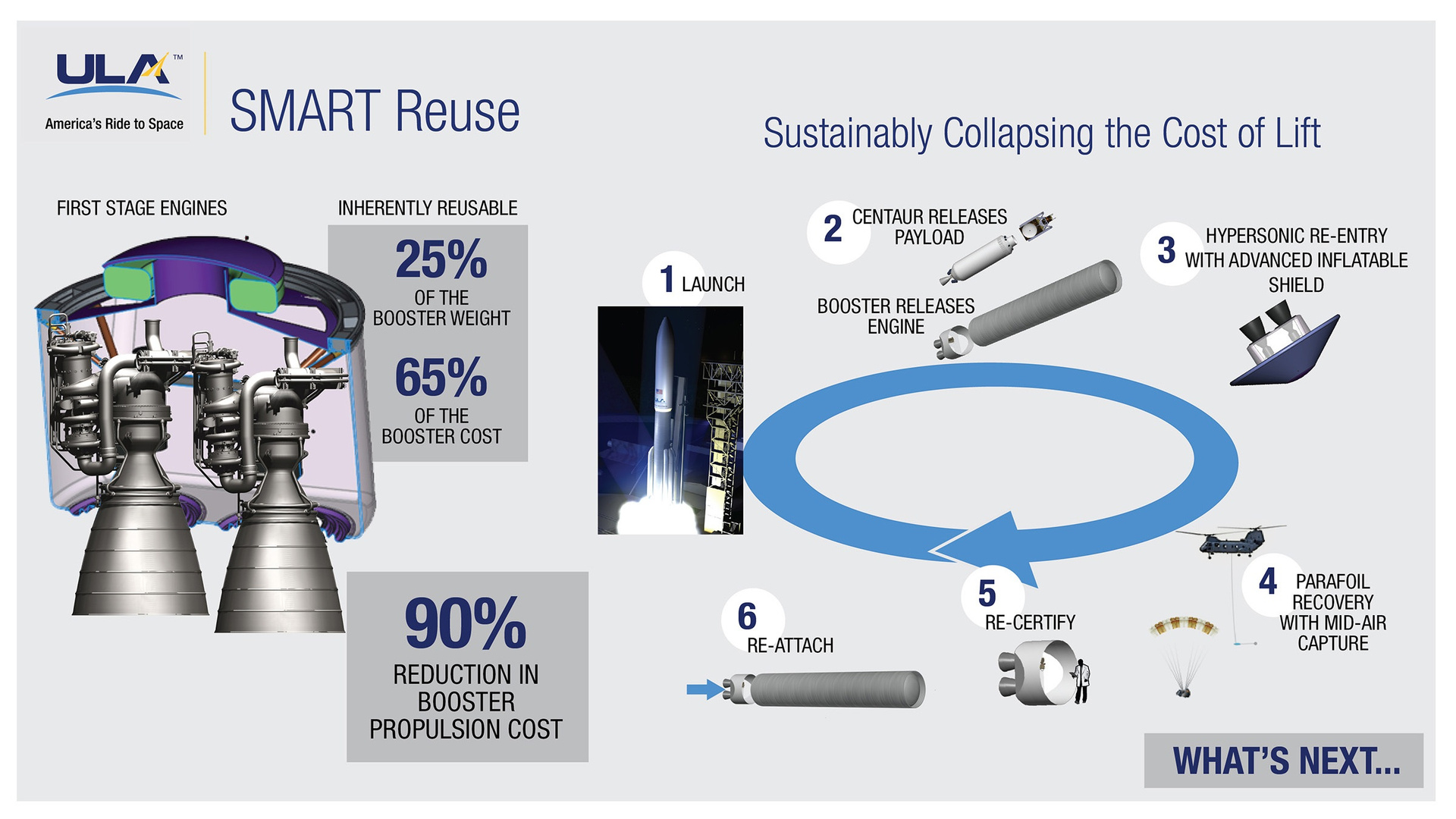
The scheme of rescue engines first stage SMART. Source: ULA
ULA introduced the concept of first-stage engine rescue and SMART avionics (Sensible, Modular, Autonomous Return Technology). The engines are separated from the accelerator, after the separation of the first and second stages. Inflatable protection is revealed, which helps to slow down the fall of the engine block below supersonic speed and then, parachuting the block, they save the helicopter in the air.
Without an increase in the frequency of start-ups, the company does not see the expediency in reusability. The total savings will be up to 30 percent, but significant funds will be required for technology development. ULA will move in this direction, but the first test flight will take place no earlier than 2024.
In connection with the hype around launch prices, ULA created the Atlas 5 rocket designer site - rocketbuilder.com . It is stated that the rocket costs $ 109 million, and the heaviest with five accelerators, capable of bringing 8856 kg, $ 157 million to GPO. Indirectly, the high price of launches can be said that from 2010 out of 52 launches, only 4 were commercial. ULA CEO Tori Bruno stressed that in just a few years, the minimum price tag was reduced from $ 191 million to $ 109 million.
European Space Agency (ESA)
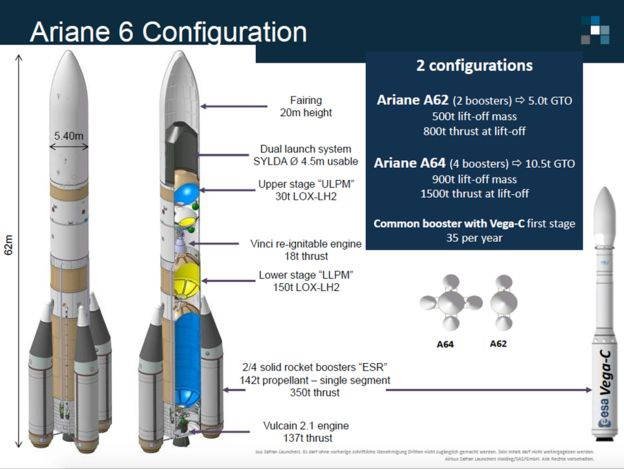
PH Ariane 6. Source: Airbus Safran Launchers (ASL)
The European Space Agency is now using the Vega and Ariane 5 launch vehicles, the components of which are produced in the whole list of EU countries and are quite generously subsidized. At the same time, the commercial launch of Ariane 5 costs $ 180-240 million, but launches 2 heavy satellites at a time (total 10 tons), due to which it has a great market demand.
The design of Ariane 6, which is the successor of the current Ariane 5, was introduced in 2012 with a planned first launch in 2020. Initially, the design represented 3 solid-fuel boosters in the first stage and one in the second stage to output 6500 kg per GPO. The development was sponsored by ESA (the project was estimated at 4 billion euros - now reduced to 2.4 billion euros), and Airbas Safran Launchers (ASL) was chosen as the main contractor. Subsequently, the design was revised in favor of greater cost-effectiveness, due to the expansion of SpaceX, which directly competes for commercial launches. The final design assumes 2 versions: Ariane A62 and Ariane A64 with two and four solid fuel boosters. The price and payload for GPO respectively 5000 kg for 75 million euros and 10500 kg for 90 million euros. Reducing the cost of start-up should occur due to the reorganization of production, reducing the number of staff by 30% from 8,000 people, using 3D printing and rejecting vertical assembly. The rocket will be assembled horizontally at Le Mirabeau, after which it will be transported to French Guiana for the integration of accelerators and payloads. It is planned to reach the schedule of 11-12 starts per year until 2023.
The ESA allocated the first tranche of 80 million euros to create a new Prometeus reusable rocket engine operating on methane + liquid oxygen fuel vapor. The cost of one engine will be 1 million euros - only one tenth of the cost of the current first-stage hydrogen engine Vulain 2 for Ariane 5 PH. Fire tests will begin in 2020 with the first flight in 2030.
Roscosmos
The price of “Proton” varied depending on the market conjuncture in order to remain a competitive carrier. So in 2014, the cost was $ 115 million, now it has been reduced to $ 70 million, as opposed to the Falcon 9 PH with a fixed price of $ 62.5 million.
Despite the fact that Proton will fly until 2025, it was decided to create cheaper versions of Proton Medium and Proton Light by 2020. It was decided to lengthen the tanks of the first and third stages and completely get rid of the second. As a result, the payload for GPO will be comparable to Falcon 9. The management of the Center for them. Khrunicheva believes that the cost of the rocket will be reduced by 25% compared with the Proton-M launch vehicle, which will bring the launch cost closer to $ 50-55 million.
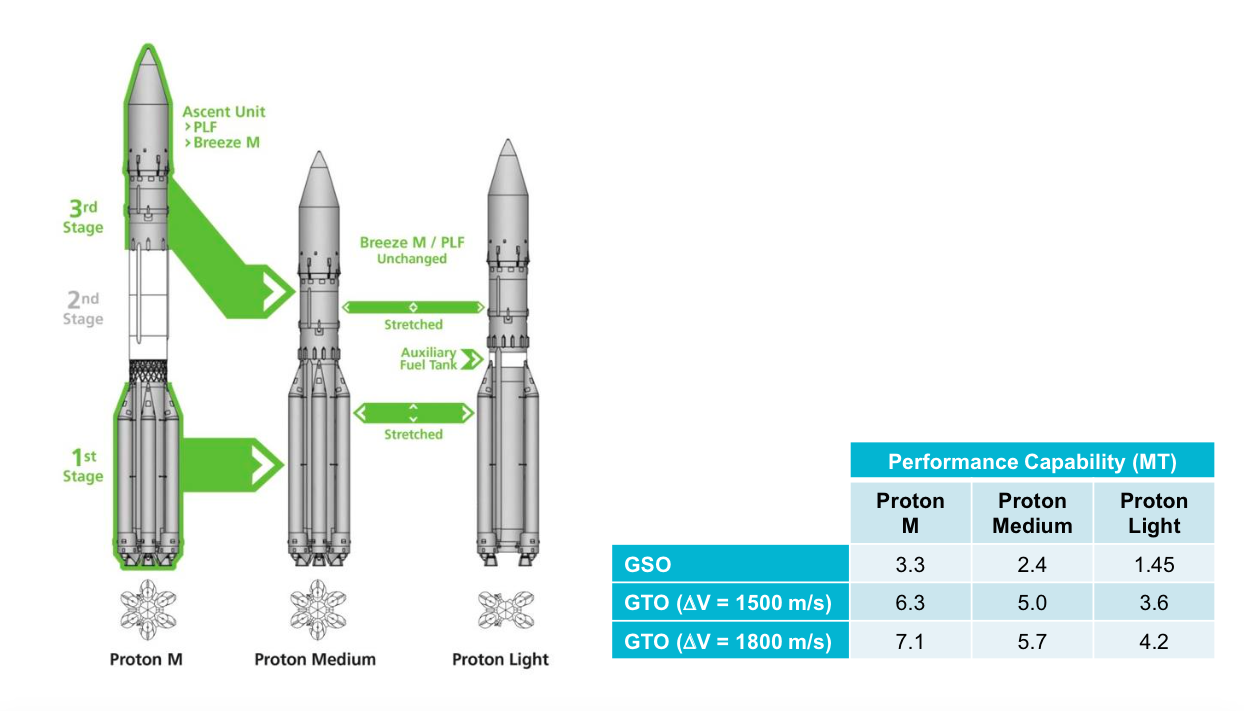
Comparison of modifications "Proton". Source: ILS
After a break in relations with YuzhMash, a replacement of the average Zenit rocket launcher, which had the lowest launch price in its weight category and which was probably inspired by Ilon Musk, is being developed within the framework of the ROC Phoenix. The new RN Soyuz-5, aka Sunkar, will use Zenith launch tables, both at Baikonur and on the floating platform Sea Launch. Flight tests "Sunkar" should begin in 2024, according to documents "Roskosmos". And in 2025 it is planned to begin commercial operation of "Sunkara". In one of the interviews, Ilon Mask said that his favorite rocket after Falcon 9 (translated as “falcon”) is “Zenith”. Sunkar is translated from Kazakh as "falcon". Coincidence?
What about reusable systems? The Rossiyanka launch vehicle was introduced in 2007. A special feature of the project is the return and landing of the first stage with multiple activation of the standard engines. SRC them. Makeeva, as the main performer, was to produce a demonstrator of an ultralight launch vehicle with a reusable first stage. The works were planned to be carried out according to the technical specifications of TsNIIMASH in 2016.
December 12, 2011 SRC them. Makeeva presented the Rossiyanka rocket launcher at the Roscosmos competition for the development of the first stage Reusable Rocket and Space System (MRKS). However, according to the results of the competition, the order for the development of MRKS was received by the GKNPTs them. Khrunichev with the project "Baikal-Angara".
The demonstrator was not made. It is planned to conduct a design-search research on a PH with reusable first steps. The result will be the development of technical proposals and a draft concept for the development of the Russian launch vehicle system until 2035.
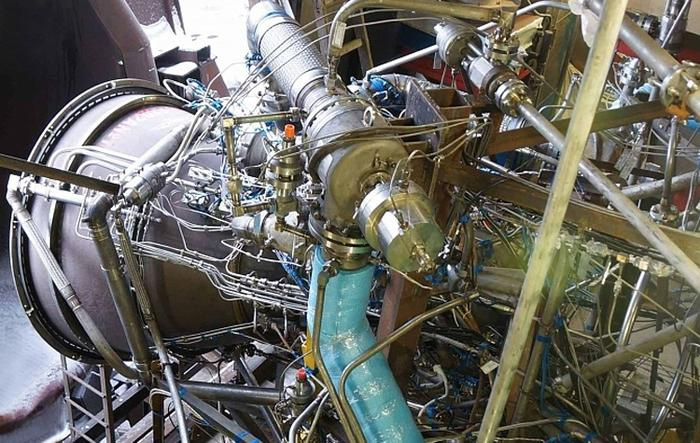
Oxygen-hydrogen engine RD0162D2A. Source: Roscosmos
In the framework of the same program, MRKS is developed by an Oxygen-hydrogen engine RD0162D2A with a thrust of 85 tons by the Voronezh Chemical Automation Design Bureau. In 2016, it was announced the allocation of 800 million rubles. The contract is for 3 years with continuation. In the future, the creation of sustainer engines up to 200 tons for MRKS. In December of the same year, the demonstrator engine was successfully tested. 10 engine starts were performed.
Jaxa
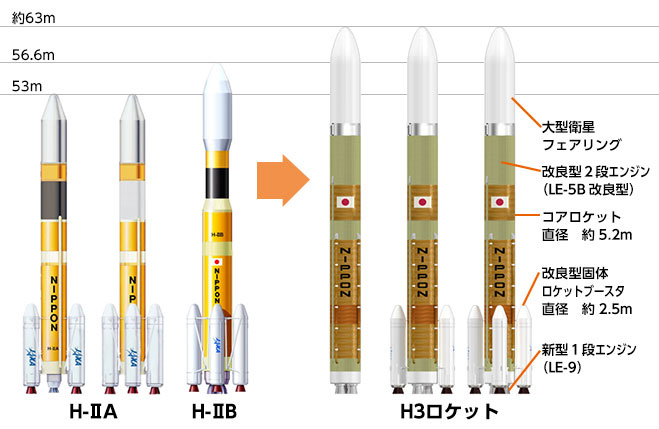
The current and future generation of Japanese launch vehicles. Source: JAXA
In 2014, the Japanese Space Agency (JAXA) signed a contract with Mitsubishi Heavy Industries (MHI) to create launch vehicles of the new generation H-3 with the first launch in 2020, which consists of 2 oxygen-hydrogen stages and up to four fuel accelerators. On the first stage, 2 or 3 LE-9 engines will be installed, depending on the configuration, with a load of 1470 kN each and a specific impulse of 426 seconds. The maximum payload per GPO will be 6.5 tons, and the lightest configuration is designed to deliver 4 tons to a sun-synchronous orbit with an estimated cost of 5 billion yen ($ 44 million) in 2015.
Also, for three years, work has been carried out in order to reduce the cost of launches by 2 times compared with the current PH H-2A and at the same time increase the number of launches twice to 8 per year. New slots launches will be directed to the use of commercial satellite launches. The first commercial launch took place in November 2015, when the Canadian telecommunication satellite Telstar 12 Vantage was launched into orbit. 2 more launches are scheduled for 2018 and 2020.
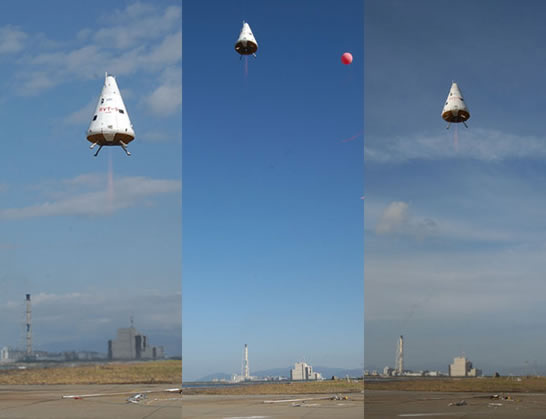
RVT in flight. Source: ISAS
It is noteworthy that from 1998 to 2003 JAXA conducted research on reusable vertical take-off and landing systems as part of the Reusable Vehicle Testing (RVT) project by the Institute of Space and Astronautical Science (ISAS) at the Noshiro Rocket Testing Center in northern Japan. It was built 4 test sample for ground and flight tests. Samples received many improvements: aerodynamic shell, position monitoring system using nitrogen, composite tanks for hydrogen and oxygen storage, GPS navigation system and the ability to restart the engine in flight. In flight, a height of 42 meters was reached, and the landing accuracy was 5 cm. All developments were proposed for the next generation, capable of bringing the payload of 100kg to a height of 100km. Despite the promise of technology, the project was closed. There is no information on whether JAXA will copy the SpaceX approach or will not pick up its old practices, although now it is becoming more relevant than ever.
Results
The reaction of SpaceX opponents is somewhat belated, which can be explained by the conservatism of the space industry. By 2020–2021, many solutions will be flown: here Proton Light, Vulcan (ULA), New Glenn (Blue Origin) and Ariane 6 (Arianespace). These will be more cost-effective carriers, but SpaceX is not idle. The company made 10 starts this year and is going to carry out 12 more, and in 2019 there are 52 start-up plans, an incredible figure. The plank is set by management high and often not achieved, but their confidence can be explained: at the end of the year, the Falcon 9 Block 5 will fly, which is designed so that the first stage can be launched 10 times with minimal maintenance and without replacing essential components. Also in 2018, they promise to save the head fairing, the cost of which is estimated at $ 5-6 million. The first re-launch of the first stage has already cost half the cost of building a new one, although not the cost of the launch vehicle comes to the forefront but its availability to start the load. Even with a single restart of the first stage, the fleet of available carriers increases by 2 times. Now SpaceX has more than 50 orders in the launch manifest, competitors have everything in the next 2-3 years, what is happening now will have consequences only in a few years. But now we can say that in the absence of Falcon 9 crashes, SpaceX will capture most of the commercial launch market.
UPD: Added summary tables for output mass and price for various launch vehicles.
Thanks for the tables @ voyager-1 .
Existing rockets:
| Title | Load on NOU, kg | Load on GPO, kg | Price, million $ | The price per kg per NOU, $ | A country |
|---|---|---|---|---|---|
| Falcon 9 | 22800 | 8300 | 62 | 2700 | USA |
| Proton-M | 23,000 | 7100 | 65 | 2900 | Russia |
| Angara | 3800-25800 | 3600-12500 | 100 | 3900 | Russia |
| PSLV | 3800 | 1300 | 15 | 4,000 | India |
| Union | 9000 | 3250 | 48 | 5300 | Russia |
| GSLV Mark III | 8,000 | 4,000 | 46 | 5800 | India |
| GSLV | 5000 | 2500 | 36 | 7200 | India |
| Atlas v | 9800-18810 | 4750-8900 | 109-153 | 8100 | USA |
| Arian 5 | 16000-20000 | 6100-10865 | 165-220 | 10300 | Europe |
| Vega | 2000 | 25 | 12500 | Europe | |
| Delta IV | 9420-28790 | 4440-14220 | 375 | 13,000 | USA |
| Epsilon | 1200 | 38 | 31700 | Japan | |
| Minotaur IV and V | 1735 | 342 | 50 | 34700 | USA |
| Pegasus | 450 | 56.3 | 140800 | USA | |
| Antares | 6120 | USA | |||
| Long March 5 | 25,000 | 14,000 | China | ||
| Long March 6 | 1500 | China | |||
| Long March 7 | 13500 | 7,000 | China |
Planned:
| Title | Load on NOU, kg | Load on GPO, kg | Price, million $ | The price per kg per NOU, $ | A country |
|---|---|---|---|---|---|
| Falcon heavy | 63800 | 26700 | 90 | 1400 | USA |
| SLS | 70000-130000 | 500 | 3800 | USA | |
| Vulcan | 15000-23000 | 100 | 4300 | USA | |
| Arian 6 | 20,000 | 4500-12000 | 90 | 4500 | Europe |
| H3 | 4000-10000 | 2500-6500 | 50-65 | 5000 | Japan |
| Electron | 225 | 4.9 | 21800 | New Zealand | |
| Firefly alpha | 400 | 9 | 22,500 | USA | |
| New glen | 45,000 | 13,000 | USA |
All Articles